Nowhere to Turn
The Federal Reserve System may have run out of room to maneuver. Facing a looming recession, it resolutely lowered its discount rate and frantically expanded its credits. Eager to stimulate the sagging economy, it enabled and encouraged businessmen to invest more and consumers to go ever deeper into debt. Yet the specter of recession refuses to fade away.




